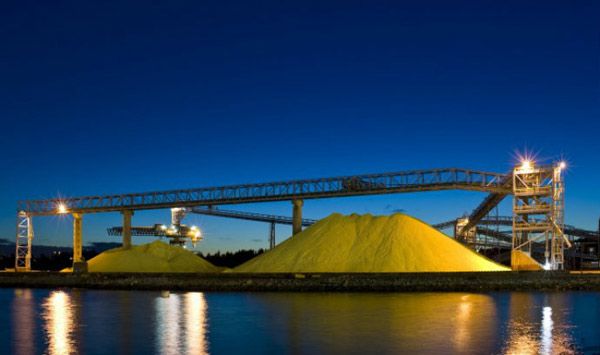Alongside the world’s major oil and natural gas refineries, says Jonas Baltrusaitis, deposits of sulfur are growing larger and larger each year. One mountain of sulfur in Kazakhstan, he says, has even been photographed from space shuttles orbiting the earth.
Elemental sulfur today occurs chiefly as a by-product of the refining of petroleum and natural gas. Sulfur is nonreactive, but as part of the compound sulfuric acid (H2SO4), it is a critical ingredient in nitrogen-based phosphate fertilizers that enrich the soil and enhance crop growth.
Baltrusaitis, an assistant professor of chemical and biomolecular engineering, wants to develop a sustainable method of processing sulfur into sulfuric acid that would “bridge the gap” between the unused mounds of sulfur and the demand for H2SO4 in fertilizers.
He is seeking to determine the optimal proportions of urea, sulfuric acid and water in fertilizers while achieving the nitrogen-to-sulfur ratio at which fertilizers work most efficiently. Urea is a nitrogen-based, water-soluble compound.
Fertilizers with lower crystallization temperatures work better in cold climates, while those that crystallize at higher temperatures are more suited for warmer climates. Baltrusaitis measures the temperatures at which phase changes from liquid to solid occur in various types of fertilizer.
His eventual hope is to develop and test fertilizers that improve crop yields and help meet global food demands, which he says are projected to rise 40 percent by 2030.
Baltrusaitis recently reported his research in the American Chemical Society’s Journal of Sustainable Chemistry and Engineering in an article coauthored with A.M. Sviklas and J. Galeckiene of the Kaunas University of Technology in Lithuania.
For several reasons, he says, the amount of sulfur in soils worldwide is falling. Oceanic emissions of dimethyl sulfate—which eventually fall on land—are decreasing due to climate change and to acidification caused by the oceans’ uptake of greater amounts of man-made CO2 emissions. And in an effort to curb acid rain, many countries have limited sulfur content in gasoline and other fuels—thus decreasing its presence in rain.
Meanwhile, an estimated 60 million tons of elemental sulfur pile up each year next to petroleum and natural gas refineries as humans gradually exhaust deposits of low-sulfur-content oil and gas and tap resources with higher amounts of sulfur.
Baltrusaitis wants to process elemental sulfur into sulfuric acid that can be incorporated into nitrogen-based phosphate fertilizers that work in both cold and warm climates.
“My goal is to return sulfur to the environment in its reactive form, as sulfuric acid, so it can be absorbed by plants and increase the efficiency of soil in uptaking nutrients. The more efficient we can make this uptake process, the greater the crop yields we will have.”
The results achieved by Baltrusaitis’s group promise to benefit the environment as well as crop yields.
Soil that contains insufficient amounts of sulfur, he says, loses its ability to absorb nitrogen and other nutrients. As a result, crops receive less than optimum nutrition, while nitrates wash away and end up polluting streams and rivers.
“Soil needs sulfur to uptake nitrogen,” says Baltrusaitis. “Without sulfur, nitrogen is not taken up but dissolved in water and washed away. The results are algae blooms in water bodies, fish dying because of the lack of oxygen, and the eutrophication of the environment.
“Everything ties together.”


